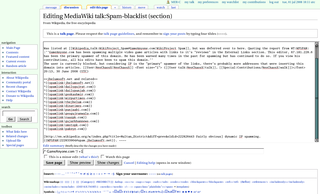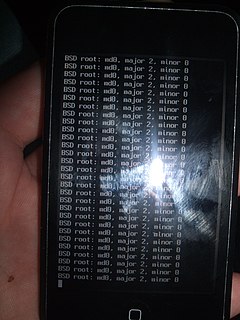 W
WIn computing jargon, the bit bucket is where lost computerized data has gone, by any means; any data which does not end up where it is supposed to, being lost in transmission, a computer crash, or the like, is said to have gone to the bit bucket — that mysterious place on a computer where lost data goes, as in:The errant byte, having failed the parity test, is unceremoniously dumped into the bit bucket, the computer's wastepaper basket.Millions of dollars in time and research data gone into the bit-bucket?
 W
WIn computing, a blacklist or a blocklist or a denylist is a basic access control mechanism that allows through all elements, except those explicitly mentioned. Those items on the list are denied access. The opposite is a whitelist which means only items on the list are let through whatever gate is being used. A greylist contains items that are temporarily blocked until an additional step is performed.
 W
WBlinkenlights is a neologism for diagnostic lights usually on the front panels on old mainframe computers, minicomputers, many early microcomputers, and modern network hardware. It has been seen on many artifacts of modern office machinery as well as, most notably, photocopiers.
 W
WThe word "brick", when used in reference to consumer electronics, describes an electronic device such as a mobile device, game console, or router that, due to severe physical damage, a serious misconfiguration, corrupted firmware, or a hardware problem, can no longer function; it therefore becomes as technologically useful as a brick, hence the name.
 W
WIn computing, a crash, or system crash, occurs when a computer program such as a software application or an operating system stops functioning properly and exits. The program responsible may appear to hang until a crash reporting service reports the crash and any details relating to it. If the program is a critical part of the operating system, the entire system may crash or hang, often resulting in a kernel panic or fatal system error.
 W
WA hashtag is a metadata tag that is prefaced by the hash symbol, #. Hashtags are widely used on microblogging and photo-sharing services such as Twitter and Instagram as a form of user-generated tagging that enables cross-referencing of content sharing a subject or theme. For example, a search within Instagram for the hashtag #bluesky returns all posts that have been tagged with that hashtag. After the initial hash symbol, a hashtag may include letters, digits, and underscores.
 W
WSneakernet is an informal term for the transfer of electronic information by physically moving media such as magnetic tape, floppy disks, optical discs, USB flash drives or external hard drives between computers, rather than transmitting it over a computer network. The term, a tongue-in-cheek play on net(work) as in Internet or Ethernet, refers to walking in sneakers as the transport mechanism.
 W
WIn information systems, a tag is a keyword or term assigned to a piece of information. This kind of metadata helps describe an item and allows it to be found again by browsing or searching. Tags are generally chosen informally and personally by the item's creator or by its viewer, depending on the system, although they may also be chosen from a controlled vocabulary.
 W
WIn computer hardware, a white box is a personal computer or server without a well-known brand name. For instance, the term applies to systems assembled by small system integrators and to home-built computer systems assembled by end users from parts purchased separately at retail. In this latter sense, building a white box system is part of the DIY movement. The term is also applied to high volume production of unbranded PCs that began in the mid-1980s with 8 MHz Turbo XT systems selling for just under $1000.